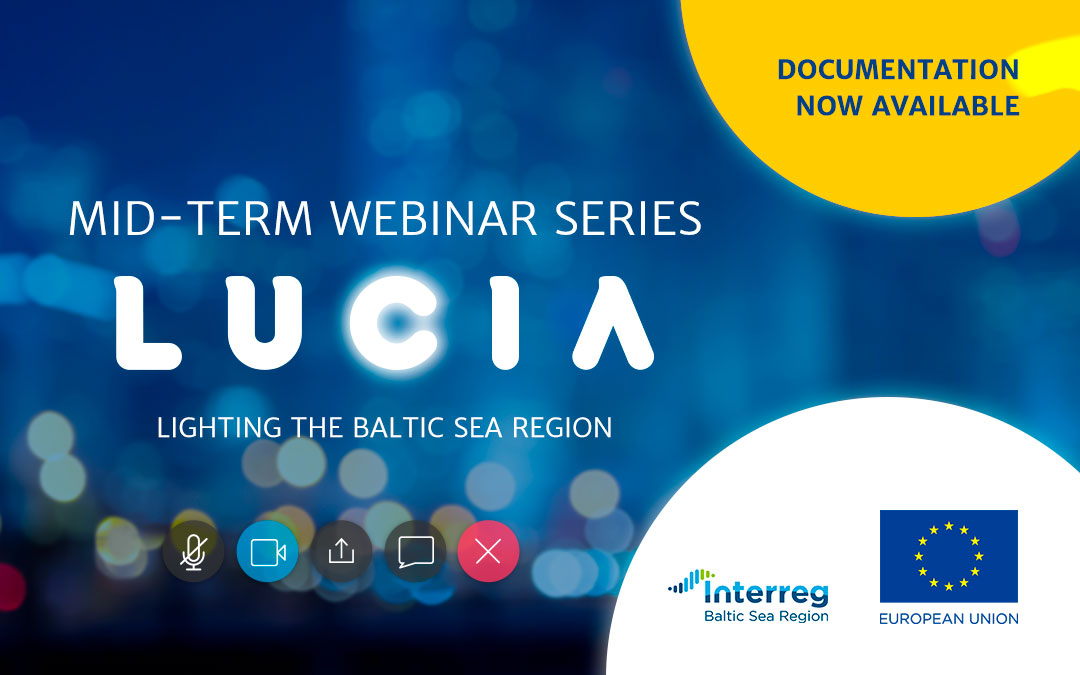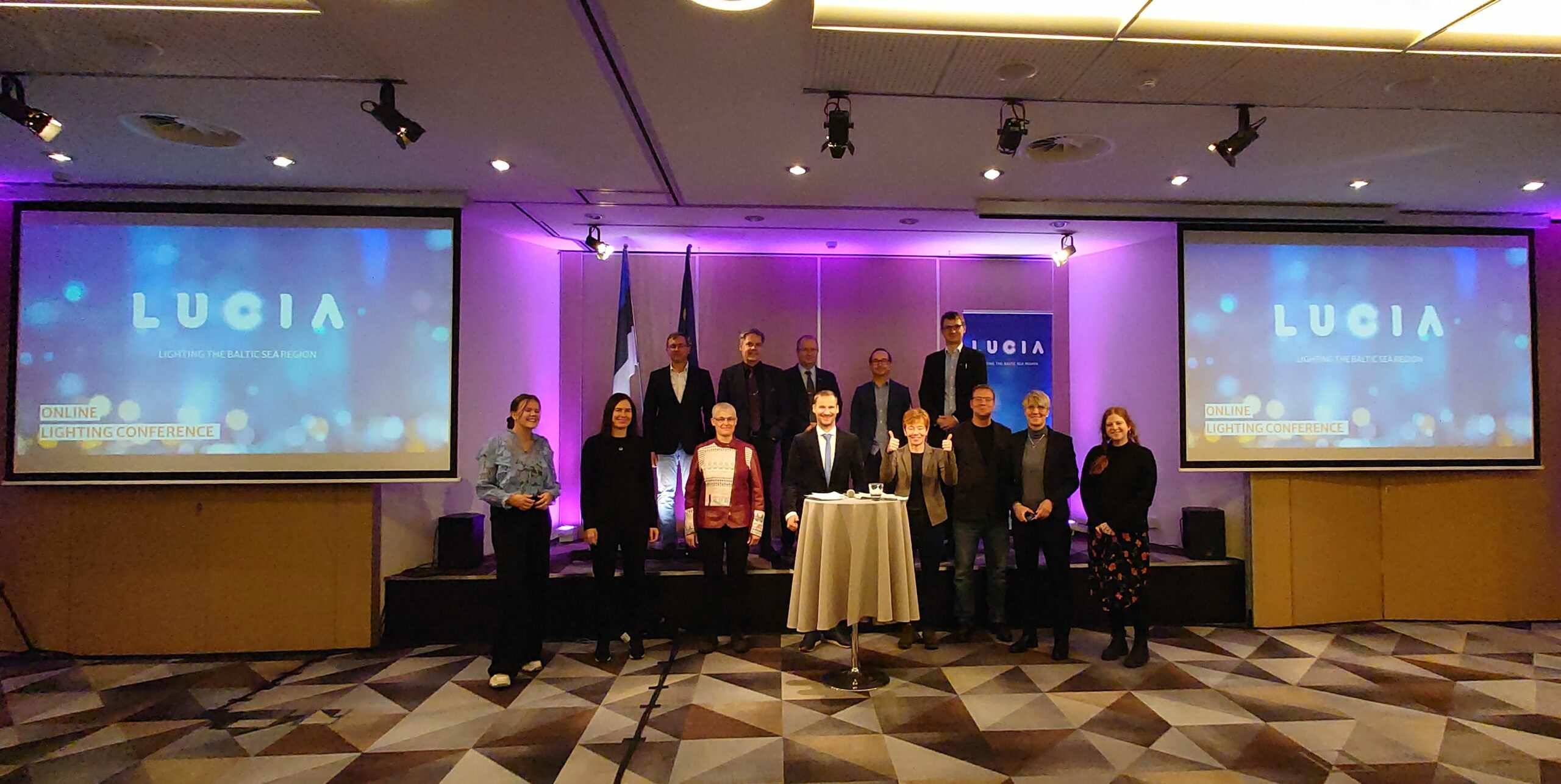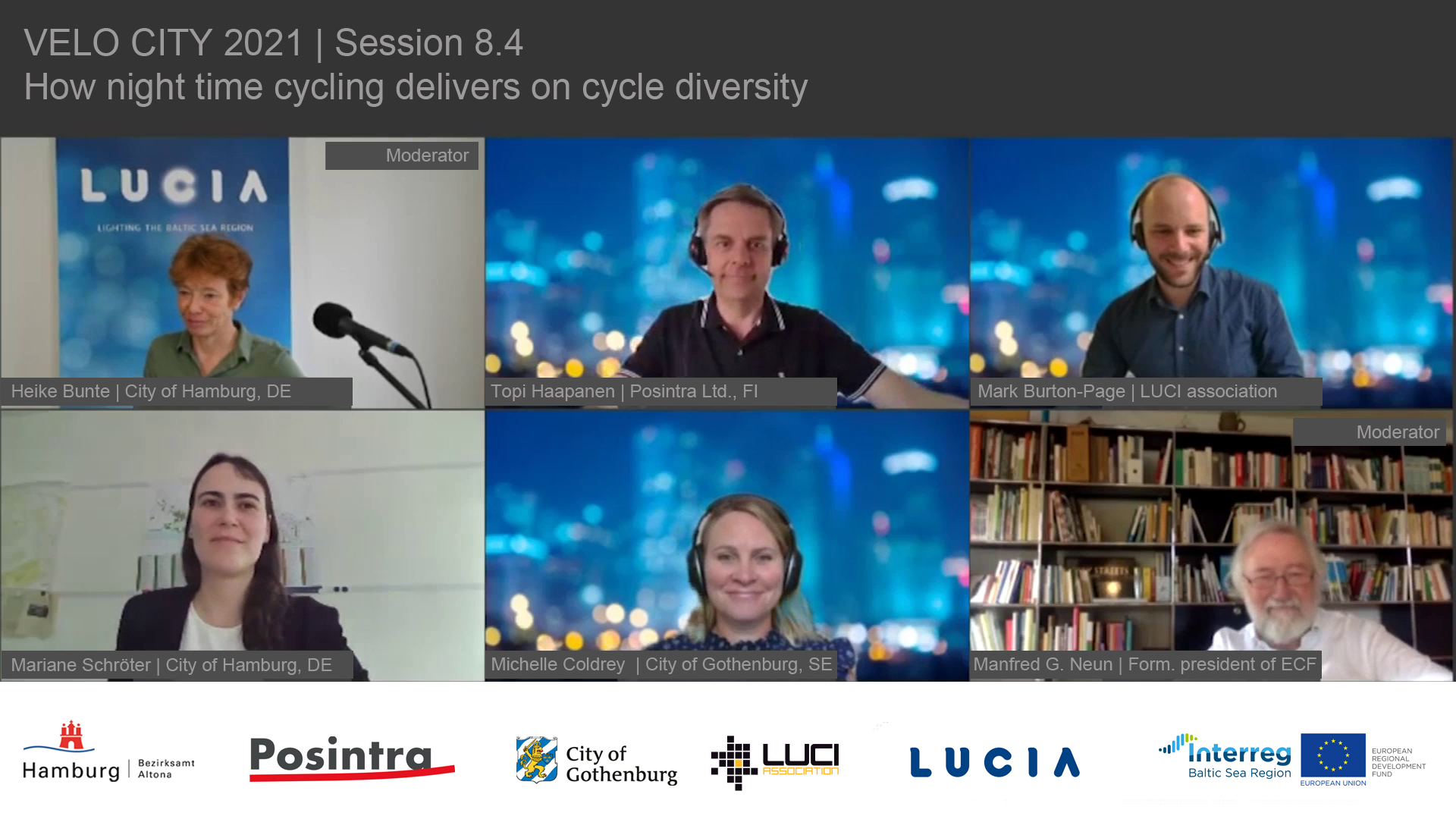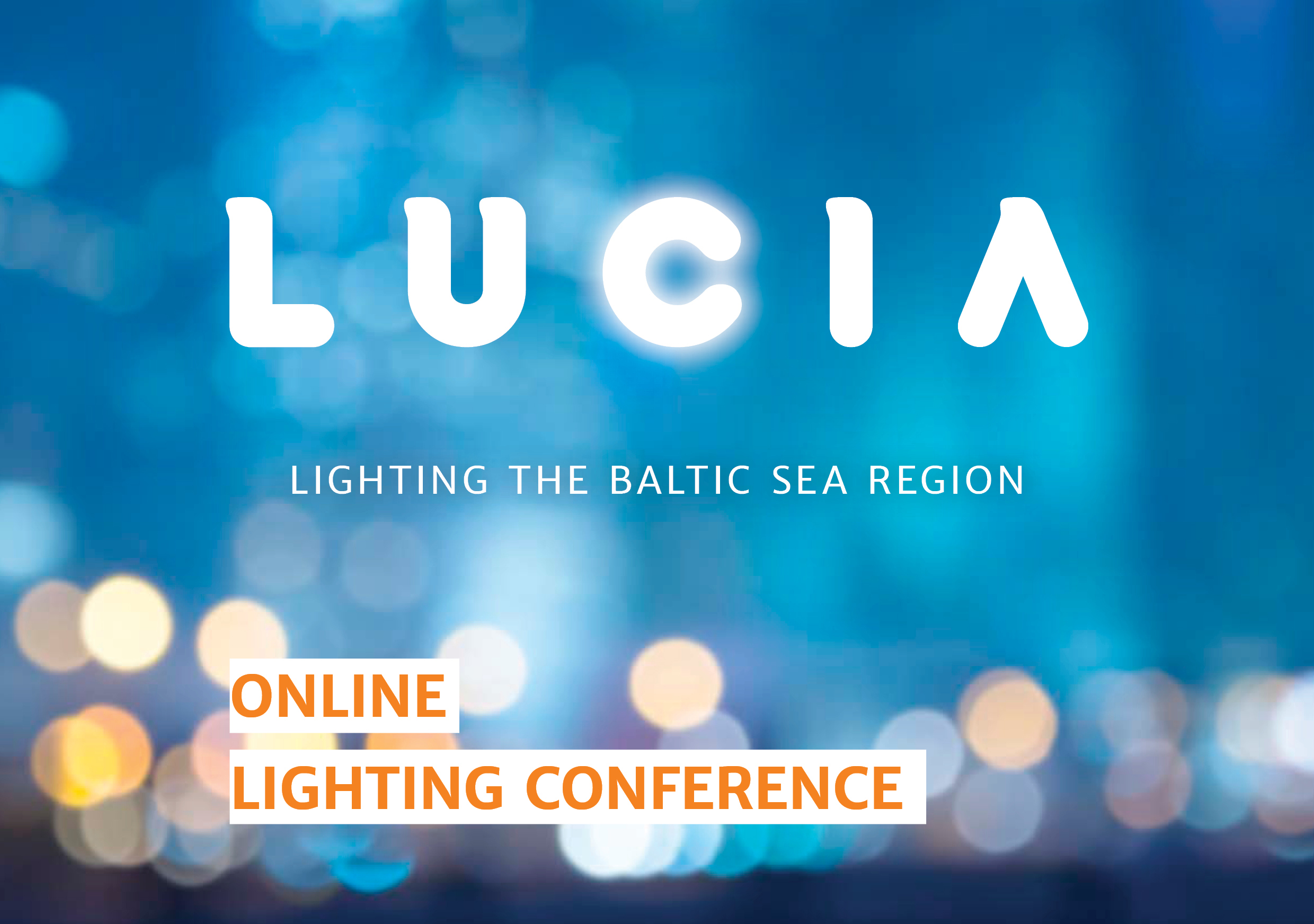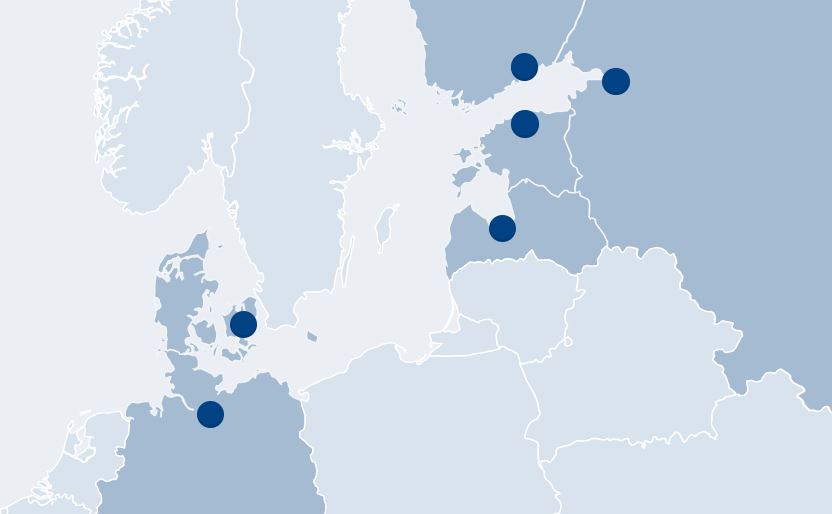Over a period of six weeks, more than 170 lighting professionals from different parts of the Baltic Sea region joined our mid-term webinars and had the possibility to learn about the many different aspects of public lighting, to get insights into interim results of our LUCIA pilot projects and to be inspired by the presentations of experts from many different fields.
The documentation of our six mid-term webinars held in the period 30 September – 4 November 2020 is now available. Click on the title of the respective webinar below to read the conclusions, download the presentations and watch the recording of the webinar:
- 30 September 2020: People first – Cooperation for a smarter city
- 07 October 2020: Urban design – Creating liveable urban spaces and fostering sustainable tourism
- 14 October 2020: Target groups – Managing needs and demands towards urban lighting
- 21 October 2020: Economic aspects – Scaling up green procurement and investments in intelligent urban lighting
- 28 October 2020: Technical solutions and circular economy aspects of smart urban lighting and smart city projects
- 04 November 2020: The future of urban lighting…is now!
You can also download the documentation as a PDF document.
#1: People first – Cooperation for a smarter city
Date: 30 September 2020, 09:30–11:00 CEST
Co-hosts: TalTech & Tallinn Urban Environment and Public Work Department
Moderator: Tarmo Korõtko, TalTech
Speakers and presentations
- Introduction to the LUCIA webinar series · Thomas Jacob, Senate Chancellery, Free and Hanseatic City of Hamburg – download presentation
- Keynote: the role of lighting in building “people-first” smart cities · Elisa Hillgen, Lighting designer at the city of Jyväskylä – download presentation
- Tallinn’s smart city strategy · Toomas Türk, Chief of Innovation at Tallinnovation, Tallinn City Enterprise Department – download presentation
- Involving people in co-creating lighting solutions: experiences from Tallinn · Eva Tallo, Chief Specialist at Tallinn Urban Environment and Public Works Department – download presentation
Conclusions
Putting people in the focus and empowering citizens to actively co-create solutions for their city has gained increasing attention in the smart city discussion during recent years. This webinar explored the role of lighting in building “people first” smart cities. The LUCIA partner city Tallinn illustrated how this approach is taken into account in the city’s smart city strategy and co-creation practices.
The presentations and discussions with participants focused on the following questions:
What does the “people first“ approach mean for the discussion on smart cities?
- Cities are made for people: It’s not the technology that is in the centre of a smart city, it’s rather educated, active and connected communities that are a prerequisite for achieving smart solutions.
- To build a common vision on the urban environment, a high level of connectivity and constant communication in the quadruple helix is required. For cities, this means that being in touch with its citizens, businesses, academia and the civil society is key.
- For cities, this means that they need to gain a high level of trust and ensure a high transparency to be considered a partner by its citizens, business, academia and civil society.
- This also requires less bureaucracy and better and trustful connections between different city departments.
- The “people first” approach to smart cities can go hand in hand with the green transition and support it.
How can we make sure that the “people first” approach is taken into account in implementing smart lighting?
- In lighting projects, we need to work together with citizens and ask them smart questions to find out what can be done better.
- We need to put the problem first and the solution last. This also means we need to be open to (lighting) solutions that might differ quite a lot from our own initial assumptions.
- A “people first” approach in implementing smart lighting projects also means to work with lighting as a tool to support healthy and active lifestyles of citizens, e.g. by enabling them to be active outside during dark hours.
What should we take into account in co-creation processes for lighting projects?
- Citizens do not always know what is good and bad lighting. Therefore, playful and experimental approaches to experiencing light (e.g. guerrilla lighting actions) can be a good way to empower citizens.
- Test environments (e.g. living labs) are a powerful way to invite citizens to test different lighting solutions and gather feedback and comments on them.
- Co-creation processes require resources – time and money. This should not be underestimated.
#2: Urban design – Creating liveable urban spaces and fostering sustainable tourism
Date: 07 October 2020, 09:30–11:00 CEST
Co-hosts: Jūrmala City Council & Riga Planning Region
Moderator: Ilgvars Francis, Riga Planning Region
Speakers and presentations
- Keynote: Lighting to create liveable attractive environments · Ulrike Brandi, Founder and managing director of “Ulrike Brandi Licht” and “Brandi Institute for Light and Design” – download presentation
- Lighting to foster sustainable tourism: the case of Jūrmala · Ieva Šponberga, Development Department, Jūrmala City Council – download presentation
Conclusions
Lighting is a powerful tool that helps cities to create liveable and attractive urban spaces – for the benefit of both inhabitants and visitors. This webinar explored how cities and municipalities can unlock this potential. It also provided insights into the LUCIA pilot project in Jūrmala, one of Latvia’s most popular tourist destinations.
The presentations and discussions with participants focused on the following questions:
How can lighting master plans help to create liveable urban spaces?
- In planning and designing lighting for cities, there is a lot we can learn from observing natural light. This refers both to light temperatures, the importance of darkness and the different heights of light.
- These principles of natural lighting can be applied in lighting master plans:
- higher light points with brighter lights for putting special focus on highlights, important buildings and landmarks providing orientation,
- lower light points for private light creating cosiness, e.g. in neighbourhood streets,
- lowest light points in areas where we want to be able to enjoy the darkness, e.g. next to the water.
- We need a holistic way to look at public lighting in cities. All light sources are important for creating the overall atmosphere and identity of cities. This includes both creative lighting, functional lighting, street lighting, pedestrian lighting and lit advertisements.
- Liveable and attractive places are not necessarily the ones with spectacular “wow effects”, but such places that make people feel comfortable and give them the opportunity to meet each other.
- To make sure lighting master plans are really implemented, it is crucial to install a group of people accompanying the plan’s realisation and to make sure there are financial resources and political support for its implementation.
- Reducing and minimising the negative effects of light pollution should be art of all lighting master plans and simple rules (e.g. smaller angles of light without dazzling) should be included in master plans.
Which lessons can we learn from the LUCIA pilot project in Jūrmala?
- For a city considering to start a lighting (upgrade) project, it’s crucial to identify the needs and demands of citizens and local entrepreneurs towards public lighting.
- When doing so, we should be prepared for diverse and partly contradicting views.
- In Jūrmala’s case, the following aspects were the main points identified from surveying residents and entrepreneurs:
- Whereas many locals see the need for improving and upgrading the lighting, a large share suggest to preserve a traditional retro design.
- More brightness and higher security was often demanded; this has resulted in plans to include sensors for pedestrian flow in the technical design and foresee the possibility to add on cameras in the future.
- For a tourist resort city such as Jūrmala, the lighting of its central pedestrian street plays a key role in attracting tourists and building the image of the city. A well planned lighting can thus benefit both citizens, entrepreneurs and tourists.
#3: Target groups – Managing needs and demands towards urban lighting
Date: 14 October 2020, 09:30–11:00 CEST
Co-hosts: Free and Hanseatic City of Hamburg, Borough of Altona & Peter the Great St. Petersburg Polytechnic University
Moderator: Tommi Vollmann, atene KOM
Speakers and presentations
- Keynote: Is less more? Managing diverse needs and demands towards public lighting · Andreas Hänel, Leader of the Dark Sky working group, Association of Star Friends – download presentation
- Generation 65+ in the focus – experiences from Hamburg · Heike Bunte, Lead Partner LUCIA project, Free and Hanseatic City of Hamburg – download presentation
- Students in the focus – experiences from St. Petersburg · Yury Nurulin, Professor at Peter the Great Saint-Petersburg Polytechnic University – download presentation
Conclusions
Do we need less light to preserve dark skies and protect biodiversity? Or more light to increase the perceived safety of public spaces? This webinar explored how cities and municipalities can manage diverse needs and demands towards public lighting. LUCIA partners from St. Petersburg and Hamburg shared their experiences on working together with the target groups of students and elderly citizens, respectively.
The presentations and discussions with participants focused on the following questions:
What is light pollution and how can cities reduce it?
- The term light pollution is used to describe phenomena such as glare through bright light sources, trespass light and light scattered towards the sky.
- Light pollution has increased through upgrading to LED lighting, which often goes hand in hand with the installation of brighter and brighter luminaires.
- Light pollution has a negative impact on biodiversity, human health as well as our possibilities to observe the starry sky.
- Cities can use the following strategies to reduce light pollution:
- Only install lighting where it is really needed,
- Use lowest possible amount of lighting according to existing norms (EN 13201),
- Pay attention to correct direction of light and use full cut-off luminaires,
- Use low blue content (max 3000 K),
- Adaptive lighting: only illuminating when light is needed.
- The discussion on LEDification during recent years has mostly focused on energy efficiency and municipalities have been looking for the most energy efficient lights. The challenge is that the most energy efficient lights are cold blue lights with 4000-5000 K, but these are not the most ecologically efficient lights that are good for humans and nature. The discussion needs to focus more on ecological efficiency.
Does more and brighter light mean more security?
- More light does not automatically mean more security. Studies show there is no evidence that reduced street lighting is associated with increases in road traffic collisions or crime.
- Surveys implemented after the artistic redesign of a narrow tunnel at Hamburg’s pilot site showed that overall atmosphere is more decisive for perception of safety than the amount of lighting itself. Colours used in the wall paintings seem to have a larger effect.
How can city administrations deal with different demands towards public lighting?
- Negative effects of light pollution are still not widely recognized, therefore constant awareness raising and educational activities are needed to increase the knowledge on lighting and foster a holistic understanding of it.
Stricter guidelines and legislation are also needed to counteract light pollution and avoid unnecessary or harmful lighting.
#4: Economic aspects – Scaling up green procurement and investments in intelligent urban lighting
Date: 21 October 2020, 09:30–11:00 CEST
Co-hosts: City of Porvoo & Posintra Ltd.
Moderator: Topi Haapanen, Posintra Ltd.
Speakers and presentations
- Keynote: Economic governance and procurement for the transfer of smart urban lighting investments Carlos Lamuela, Urban consultant and researcher, FCG Design and Engineering Ltd – download presentation
- Green procurement for outdoor lighting – The existing regulation, its characteristics and examples Janis Brizga, Head of the Board, Smartgreen Ltd. & NGO Green Liberty – download presentation
- Green procurement for outdoor lighting – Experiences of procurement in Porvoo Elina Leppänen, Planning manager, City of Porvoo – download presentation
Conclusions
Budget constraints and a lack of knowledge about project financing are major factors contributing to a slow diffusion of smart lighting solutions in the Baltic Sea region. This webinar explored how cities and municipalities can break free from budget-deficit inaction and develop and implement new procurement and business models. LUCIA partners gave insights into the economics and green public procurement practices of public lighting in Porvoo (Finland) and Riga Planning Region (Latvia).
The presentations and discussions with participants focused on the following questions:
What are the main obstacles for municipalities to develop new business models around smart lighting and how can we overcome them?
- In municipalities, innovation is often only considered in terms of outsourcing services. It is therefore of key importance to also think about technology innovations for enabling roles for the municipality and its citizens.
- In municipalities, we often meet “projectification” or “project thinking” focussing on particular cases and small decisions instead of sustainability thinking. Considering how smart lighting relates to all other municipal functions can help to see the bigger picture.
- When planning an investment, it’s often difficult to cooperate across silos as it’s unclear who will benefit most after the investment. Starting to talk about the goals (e.g. climate goals) and then working backwards from these to define different possible paths can help in this situation.
- Investments in smart urban lighting are often only framed as a way to achieve savings. Considering them as a good practice of new institutional economics for a “fair energy transition” could open new perspectives.
Which experiences are there in working with green public procurement for outdoor lighting in Baltic Sea region municipalities?
- There are a number of recent outdoor lighting projects on municipal level where green public procurement criteria have been applied. Examples from Latvia and the LUCIA pilot site in Porvoo, Finland were presented and discussed in the webinar.
- Nevertheless, there are still many information, economic and technical barriers hindering a wider uptake of GPP and modern lighting technology in general.
- Some of the GPP aspects are particularly complicated for municipalities. This is why trainings, guidelines and templates for procurement organizers are needed.
- Experiences from Porvoo show that evaluating “green thinking” in the procurement process requires much more effort than evaluating traditional criteria such as experience or degree of a person.
- A critical point for the success of green procurement is to convince decision makers that enough financial and time resources are needed to make environmental solutions work for the benefit of all people.
- Often, the costs are underestimated during the design process. More dialogue between lighting designers, consultants and producers already in early stages of a project could be a part of the solution.
#5: Multifunctionality – Technical solutions and circular economy aspects of smart urban lighting and smart city projects
Date: 28 October 2020, 09:30–11:00 CET
Co-hosts: City of Albertslund & Gate 21
Moderator: Sif Enevold, Gate 21
Speakers and presentations
- Technical solutions for smart lighting · Jens Hammer, Living Lab Coordinator, DOLL Living Lab and Gate 21 – download presentation
- Circular economy and what to consider for municipalities · Maja Johannesen, Metabolic – download presentation
Conclusions
Smart lighting solutions are getting more and more advanced. The webinar introduced different technical solutions of smart lighting, with an emphasis on dynamic lighting and movement sensors, as well as other aspects of smart solutions.
DOLL Living Lab presented the LUCIA pilot site in Albertslund on dynamic lighting solutions with different technical movement sensor solutions.
The webinar also looked at circular economy in general and how municipalities can take circular economy aspects into account in the decision process.
The presentations and discussions with participants focused on the following questions:
How can we benefit from multifunctional add-ons to lighting?
- DOLL Living Lab has a lot of experience with multifunctional add-ons to lighting. Every of DOLL’s 80 units are LED-based and controllable. This allows to optimise the installation.
- Motion detection is the main focus in DOLL and the aim is to have a wide variety of sensors tested (IR, radar, combined IR/radar, noise, video node based sensors).
- If motion detection systems are well design, they can provide a lot of additional value to citizens and save a lot of energy and costs. Well-designed systems (e.g. systems with long ramp times) are not recognized by the majority of the users.
- Today, prices for motion sensors have decreased. If systems are installed while upgrading luminaires to LED, the ROI can be 4-5 years, but it depends on the electricity price. The Nordic countries are forerunners in applying motion sensors due to the relatively high energy prices.
- Finding the right system that provides maximum freedom is a complex task for municipalities. There are about 15,000 standards in smart city solutions, but some of them are getting more broadly used. It’s important to clearly define the needs to find out which system might be the best one for the specific area and context.
How can we take into account circular economy aspects in public lighting?
- To get circular economy thinking into outdoor lighting, we can for example look at the product design of luminaires: is it possible to maintain and update / upgrade key components?
- We can also look at service-based business models that might create incentives for the producer to build really energy efficient devices.
In municipalities, there is a growing demand for smart city technologies with long warranty periods of about 10 years. This shows that systems with a longer life span are being valued more and more compared to the cheapest available technology.
#6: The future of urban lighting…is now!
Date: 04 November 2020, 09:30–11:00 CET
Co-hosts: City of Gothenburg & LUCI Association
Moderator: Camille Chaumeron-Jourdan, LUCI Association
Speakers and presentations
- Opening remarks · Toni Orsulic, City of Gothenburg
- Lighting the resilient City · Mark Burton-Page, LUCI Association – – download presentation
- A light on the future: Opportunities for improving public space with smart lighting, lessons from the Smart Space project · Rianne Valkenburg, Intelligent Lighting Institute, Tu/e – download presentation
- Light in the post pandemic landscape! Janica Wiklander, OKIDOKI Architects – download presentation
- Closing words · Heike Bunte, LUCIA Lead Partner, Hamburg-Altona
Conclusions
Planning “the future” is an inherent exercise for city planners, lighting designers and managers who are building the city and its lighting for the next 15-20 years.
If the current sanitary crisis has forced us to think more about our daily lives, it has also revealed the need for cities to adapt, to continue in a sustainable way.
This session offered perspectives on the challenges and questions that transcend urban lighting today and that help us build solutions and answers for tomorrow.
The presentations and discussions with participants focused on the following questions:
What will be the major evolution of public spaces in the coming years?
- Worldwide, cities are working towards creating sustainable, liveable, safe and secure, but also inviting and welcoming urban spaces.
- Urban lighting is a tool that helps cities to do so. This is for example reflected in Gothenburg’s lighting strategy , which aims to create beautiful, safe, accessible urban spaces, clarifying the city’s form and function, strengthening the city’s character and attractiveness.
- But with the current sanitary crisis and its impacts (such as lockdowns resulting in empty streets), cities as places of socialisation and exchange between people have been challenged. This is particularly true during the night time.
- The pandemic has shown us that accessible parks and other urban spaces that allow active mobility and social interaction will further gain importance in the future. Light and lighting design(ers) can contribute a lot to a better design of such places.
- We have also seen a growing importance of communities and neighbourhoods. This means that these places should also be included in overall lighting strategies in the future because good lighting should be accessible to all, not only to people in city centres.
How will the evolution of personal mobility impact public lighting and urban lighting policies?
- During the Corona crisis (but also before), we have seen a boost to active mobility in cities throughout the world. The need for upgrading walking and cycling infrastructure in cities has become very obvious.
- As street lighting has for many years mainly been planned for cars, the question is whether our lighting infrastructure is flexible and adaptable enough to respond to new mobility trends.
- A better visibility of pedestrians and cyclists is one of the aspects we need to look at closer. Smart lighting and dimming technologies provide a lot of opportunities in that respect.
- It’s also crucial to carefully listen to the actual needs of pedestrians and cyclists to define the right solutions and scenarios.
How will new lighting technologies influence the public space in the coming years?
- Smart lighting technologies, especially adaptive lighting, has the potential to be a real game changer for public lighting in the future. If we use such technologies appropriately, they can have a huge societal value. Cities can for example adapt public lighting to make sure it is only available when and where it is needed. This also helps to tackle ecological challenges such as light pollution.
- Cities still need to understand these possibilities better. While the technological development is rapid and the issue complex, it is not rocket science to develop use cases and scenarios that respond to people’s needs and allow them to enjoy public spaces and feel comfortable in them.
- Technologically, almost everything seems possible, so the question is: where should we start? A key is to investigate the needs of citizens and to consider them as experts of their own living environment.
- This will also help municipalities to navigate through the jungle and to decide what components are needed in the smart lighting system.

